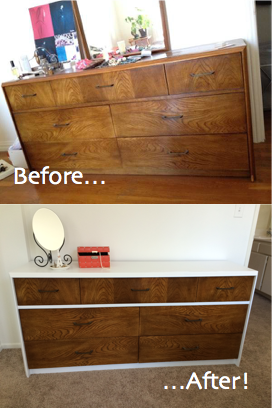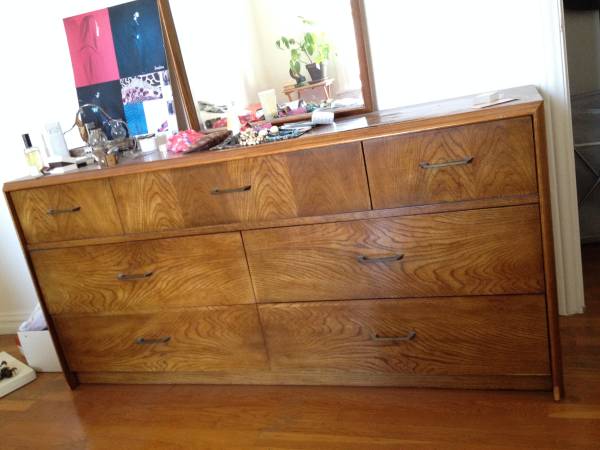If you are in my situation and are renting an apartment in which you are strictly prohibited from painting the walls in any capacity, and are tired of bland beige and washed-out white walls, then you will love this! Have you heard the new trend in covering your walls with fabric? Yes, fabric! And the materials needed you probably already have in your closet and your kitchen. I’ve been doing a lot of research lately of ways to cover/decorate your walls without paint, and I discovered several other bloggers’ posts about using fabric basically as wallpaper. I was intrigued so of course I had to give it a go.
One of my favorite blog posts on making a fabric wall, and the one that I learned the most from, you can find here.
The perfect wall to cover in my apartment presented itself to me one day while cleaning. The “breakfast bar” situated between our kitchen and living room basically serves as our only proper dining area, and so we use it daily for meals and just hanging. Unfortunately, the paint used on this wall is of extremely poor matte quality, and we’d discovered that our jeans actually rub off color onto the wall below the bar! And there’s no chance in hell that we were going to clean that wall everyday, or not sit there when wearing jeans, so we had to do something to the wall. And since we can’t paint over their crappy paint job, something else had to be done. Enter stage right, the Fabric Wall.
After carefully measuring and re-measuring the wall, I took a trip to my local fabric store to see what I could find. I ended up selecting a bright yellow fabric with an hourglass-like design. In hindsight, I should’ve bought a solid cotton fabric because this pattern, although lovely and fun, made lining up everything VERY difficult. I wouldn’t recommend using a fabric pattern your first time around. If you are dead-set on a patterned fabric, then I recommend applying the fabric in small, easy to work with square sections.
The easiest part was making the adhesive, which was just cornstarch and water. Simply mix 1/4 cup of cornstarch with 1/2 cup of cold water until it is dissolved. Then mix that with 4 cups of boiling water and boom, goop. Let this goop cool down to room temp and it’s ready to use. Think of it as paper maché for your wall, but with fabric.
After making the cornstarch mixture, I laid out my fabric and cut the pieces for the wall, leaving at least 3 inches all around the sides. Then I got to work “glueing” the smaller pieces up on the wall below the bar. I used a small paint roller and tray and rolled the goop all over the wall, then lined up the fabric and nailed little brads along the top to hold it in place while I covered it in more goop. Since this is a messy job, I put down plastic and a drop cloth, to protect the floor from getting goopy!

If you look up to the left, you can see where I tested a small piece of my material on the wall, for color fastness. This is a very important first step!
Once that section started to dry around the edges, I started with the next piece. I covered the top half of the wall with goop and nailed the section of fabric up to the wall. I had the play around with the positioning so that the pattern lined up evenly, which wasn’t too difficult since this particular section’s piece of fabric was small.
See how there’s extra fabric along the bottom? It’s like that under the bar too. I trimmed those off later with my Xacto knife. As it dried, I noticed some bubbles forming under the fabric in places, so I went back over them with more goop and smoothed them out. This ended up happening on all the sections, but was really easy to fix. I let these two small sections dry completely (overnight) before I moved on to the big section to the right.
The fabric I selected was an outdoor fabric, so it was heavy and waterproof (bad idea, don’t do this to yourself!). I ended up having Kevin help me with this part, because one of us needed to hold the fabric along the top while the other lined up the pattern along the bottom left side. This took almost an hour, and is why I don’t recommend using a patterned material your first time through this project. Once we got it lined up, we nailed brads around the top and left sides to hold it in place. While Kevin held the fabric up, I went under and covered the wall in a thick layer of goop, and then went back over in another thick layer on top of the fabric. Starting from the top and working my way down to the bottom, smoothing everything out as I went, I applied as much goop as I could. I also used heavy-duty duct tape along the edge where the fabric wrapped around the window of the kitchen, to keep it taught while it dried.

At this point I was cursing myself for buying such thick fabric with an exact pattern. Thank goodness we made it through this though, because it was SO worth the effort.
Once I got all the bubbles smoothed out and it dried completely, I used my Xacto knife to trim off the edges around the top, sides, and bottom. This was easy but time consuming. Fortunately though it was the last step!
I hope I’ve made it clear that this was no easy task, nor a one-man job. I tend to take on a little more than necessary when it comes to “first time” projects, and always look back and say, “That could’ve been a lot easier”. So, if you want to take on this project for your own home, here’s what I recommend:
- Use a lightweight, cotton fabric, in a solid color.
- Test a very small piece of the fabric and adhere it to the wall with your cornstarch mixture to make sure the color doesn’t transfer from the fabric to the wall. If it does, wash the fabric and let it air dry before beginning.
- Start with a small wall or cut your fabric into smaller pieces.
- Have a ladder, step stool, or chair to stand on to reach the ceiling.
- Get someone to help you!
- Make sure to have an xacto knife and scissors handy, as well as a paint roller and tray for the goop application, and a drop cloth.
- And be VERY careful when measuring and cutting before you start. Leave at least 3 inches of extra fabric all around your section, so you can cut a clean edge once you’re done.
The best part about all of this? When you’re ready to take down the fabric, you simply peel it off! Seriously, that’s it. You can even wash the fabric and use it again for something else, since the adhesive was just cornstarch and water. I also recommend wiping down the wall once the fabric is off, to remove any cornstarch residue that may remain.
When all is said and done, I’m so happy with this wall and am glad I had Kevin to help me through the tough part, because the end result is gorgeous! If I do this again to another wall, I will take my own advice and simplify the process for my sanity!



















